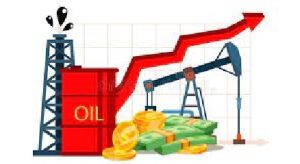Even before Ukraine Russia war crisis rising Oil prices have always been a cause a concern for Indian Economy. India is most vulnerable to Price rise of Gas, coal, edible oil, fertilizers and metals. With Price Rise Inflation can create worrisome situations. Oil’s relentless surge above $125 a barrel threatens to stoke inflation across Asia, forcing central banks to decide whether to respond to higher prices with tighter policy, or hold off amid the blow to economic growth.
Why Oil Prices are Rising ?

- Russia is the largest non-open supplier of crude oil and Gas to the World. Russia Ukraine war has led to the force majeure by Russians on the oil contracts. Insurance prices for the crude oil tankers also rose due to the war making it more costly.
- Energy giants such as Shell, BP and Exxon all pulled out of Russian energy deals, while the Biden administration has announced a ban on importing Russian oil and other petroleum products, which represents about 8% of U.S.-bound crude shipments.
- Russia’s war in Ukraine went from a threat to reality in late February, which caused crude oil prices to briefly rise above $100 a barrel before retreating back towards $90. Over the following two weeks, crude oil priced climbed steadily as the U.S. and its western allies imposed crippling sanctions on Russia.
- Russia exports about 5 million barrels a day of crude. 60% of the Russia’s Oil gets exported to European Countries and the rest 30% goes to China. Russia is the third-largest petroleum and liquid fuels producer in the world, after the United States and Saudi Arabia.
- It is also a major exporter of crude oil. Since mid-January 2022, the geopolitical risk related to Russia’s further invasion of Ukraine has contributed to higher and more volatile crude oil prices.
- Stronger petroleum demand as the COVID-19 pandemic has begun to ease and slower crude oil production growth have also put upward pressure on global crude oil prices.India imports about 85 per cent of its crude oil requirements and is the world’s third-largest consumer of oil.
- Higher prices would increase the country’s import bill at a time when it is facing a steep budget deficit.
- The Covid Recession hit U.S. and other economies around the globe, oil prices tanked along with the stock market
- Lockdowns and unprecedent disruptions resulted in less energy demand and oil prices fall.
- But Oil demand came back strong later in 2020 as national governments and central banks pumped trillions of dollars into the global economy to support workers and the unemployed. By early 2021, oil had climbed back to pre-pandemic price levels.
OPEC Production cut leads to Higher Prices
- In April 2020, a spat between Russia and Saudi Arabia over proposed output cuts in response to the new Covid-19 pandemic spooked investors, causing the price of oil to fall to historic lows in April 2020.
- The quick rebound in consumption caused crude oil and refined product inventories to fall swiftly from record high levels in mid-2020 to multi-year lows in late 2021.
- That’s why the Biden administration, despite arguing for less fossil fuel consumption overall, has called on the Organization of Petroleum Exporting Countries (OPEC) and its allies to increase oil production.
- OPEC’s plan to throttle back its oil wells, and the commitment to that plan will likely maintain upward pressure on prices.
U.S. Oil Production Slow
- U.S oil producers aren’t in a hurry to expand production. For one thing, they don’t want to invest heavily on new wells only to see supply increase, prices decline and their profits dwindle.
- This was a major theme of the fracking boom that helped propel the U.S. to become the number one global oil-producing nation over the last decade and a half. Many companies went bankrupt as they overextended themselves building out infrastructure, only to see oil and gas prices plummet on greater and greater supply.
- Meanwhile, there’s a large push by some of the world’s largest institutional investors, including BlackRock, to steer investment toward companies with low levels of environmental, social and governance (ESG) risk. That’s moved money away from oil and gas producers when those dollars would help increase production.
- Underinvestment because of ESG is one of the confluence of issues causing the oil price to increase.
Why India is most Vulnerable to Oil Price Rise ?
- India relies on overseas purchases to meet about 85 per cent of its oil requirement, making it one of the most vulnerable in Asia to higher oil prices.
- The twin blows of oil prices, already up more than 60 per cent this year, and a weakening rupee may hurt the nation’s finances, upend a nascent economic recovery and fire up inflation.
- There are concerns that elevated oil prices will fire up inflation which is already above the RBI’s tolerance range of 6 per cent.
- Oil prices are determined by global prices and there is a war-like situation in one part of the world and the oil companies will factor that in.
- India exports petroleum products – accounting for more than 13% of its total exports – to more than 100 countries.
- Demand for oil is growing at 3-4% every year in the country. In a decade, India could easily end up consuming more than 7 million barrels a day, say experts.
- Much of the oil goes into keeping some 300 million vehicles on the road and for different industries such as petrochemicals and plastics. India uses diesel to produce some 80,000 mega-watts of electricity. Diesel generators provide electricity to a lot of private housing.
- India’s tax revenues are also heavily dependent on oil. Oil accounts for more than 50% of federal excise duties – tax collected on goods produced within the country. States depend on oil taxes to shore up their revenues.
- For one, it widens India’s current account deficit when the value of imports of goods, services and investment income exceeds exports.
- Second, it puts Pressure on prices at a time when inflation has already climbed to above 6%.
- High oil prices also hurt growth and slow down the economy as people end up spending more money on energy and spend less on other things. And when growth sputters, the government’s fiscal calculations can go completely awry.
- A further slowdown triggered by an oil price shock will leave the government with less money to spend on a planned massive infrastructure push to spur growth and welfare benefits and subsidies.
What Can India Do To Combat Oil Price Rise?
- The Union Government, which is concerned about the rising crude oil prices in the international market owing to the Russia-Ukraine war, may make use of budgetary provisions to tackle the situation.
- Edelweiss Wealth Research in a note has marked out that India’s trade and current account deficit are both set to widen as crude oil prices jack up. The widening of the two deficits will drag the rupee down further.
- India’s monthly crude oil imports averaged 143 million bbl. or $11.3 billion during December 2021-January 2022, when the price of the Indian crude oil basket (ICB) averaged $79/bbl. The ICB at $117/bbl. would shore up the import bill by 48% to $16.7 billion.
- It is at this critical juncture that the Indian government is hoping for a quick de-escalation of the war, failing which muted tariff income and higher social spending will disrupt the government’s budget calculations leaving it with little to no option but to rely further on market borrowings.
- The central government will push for more domestic rice bran oil production, in a bid to counter the inflation in edible oil prices across the country.
- India has huge rice bran oil production potential, given the country’s paddy production, and that this will be exploited going ahead. India’s rice production has surged to a record high in the past few years, owing to the expansion in the area under paddy cultivation.
- The Food Corporation of India (FCI) is holding workshops with states to assess the potential of rice bran oil production in their rice clusters, and enhance the capacity of rice mills to ensure oil is extracted to the maximum.
- The government is undertaking major duty cuts in edible oil imports, and hoped that the effect of these steps will be visible soon and the prices of edible oil will start decreasing in the coming months.
- Mustard oil production in India is set to increase by 10 LT in the coming season, owing to higher area under cultivation, which will also help bring down prices of edible oils domestically.
- The central government has also asked state governments to curb hoarding and impose stock limits on edible oil and oilseeds if necessary, to bring down prices.




